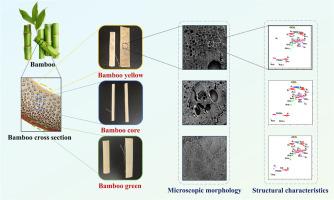碱提竹绿、竹芯和竹黄中半纤维素和木质素-碳水化合物复合物的结构特征
IF 13
Q1 MATERIALS SCIENCE, PAPER & WOOD
引用次数: 0
摘要
了解不同竹材组织中重要成分的化学结构差异,对竹材的最大限度利用和竹材资源的生物精制具有重要意义。采用碱浸法从竹青、竹芯和竹黄组织中提取半纤维素和木质素-碳水化合物复合物(LCC),并对其化学组成、热稳定性、溶出过程和结构特征进行了分析。半纤维素的提取率顺序为:竹黄;竹芯>;竹绿色。竹绿色提取的半纤维素主要来源于纤维细胞的次壁(s层)和薄壁,竹芯和竹黄色提取的半纤维素主要来源于纤维细胞的内s层和外s层以及薄壁。竹核和竹黄的lcc含有大量的I型苯基糖苷(PhGlc1)键,主要来源于这些组织的薄壁细胞壁。这些发现提供了绿竹、芯竹和黄竹碳水化合物组成结构差异的数据,为不同竹组织的高价值利用提供了有价值的指导。本文章由计算机程序翻译,如有差异,请以英文原文为准。

Structural characteristics of hemicelluloses and lignin-carbohydrate complexes in alkaline-extracted bamboo green, core, and yellow
Understanding the differences in the chemical structures of important components in different bamboo tissues is crucial for maximizing bamboo utilization and biorefining bamboo resources. Hemicellulose and lignin-carbohydrate complex (LCC) were extracted from bamboo green, bamboo core, and bamboo yellow tissues by using the alkali-leaching method, and the chemical composition, thermal stability, dissolution process, and structural characteristics were analyzed. The extraction yield of hemicelluloses followed the order: bamboo yellow > bamboo core > bamboo green. Hemicelluloses extracted from bamboo green mainly originated from the secondary wall (S-layer) of the fiber cells and parenchyma cell walls, while those from the bamboo core and yellow mainly originated from the inner S-layer and outer S-layer of the fiber cells, as well as the parenchyma cell walls. The LCCs from bamboo core and bamboo yellow contained a large number of type I phenyl glycoside (PhGlc1) bonds, which mainly originated from the parenchyma cell walls of these tissues. These findings provide data on the structural differences between carbohydrate components in green, core, and yellow bamboo, offering valuable guidance for the high-value utilization of different bamboo tissues.
求助全文
通过发布文献求助,成功后即可免费获取论文全文。
去求助
来源期刊

Journal of Bioresources and Bioproducts
Agricultural and Biological Sciences-Forestry
CiteScore
39.30
自引率
0.00%
发文量
38
审稿时长
12 weeks
 求助内容:
求助内容: 应助结果提醒方式:
应助结果提醒方式:


